With a problem undervoltage owners of summer cottages and residents of country houses often collide in the power grid. During the season, when you need to water the garden using irrigation systems, and in the cold, when you need to warm up, the voltage deficit is felt especially strongly. The reason for this is the peculiarity of the supply of electricity to such settlements - the entire street is usually powered by one transformer, the calculation of the power of which was carried out according to statistics in those distant years when not all residents could afford a TV. Today, the question is different - will residents be able to afford the repair of all equipment due to insufficient voltage?
When is such a device needed?
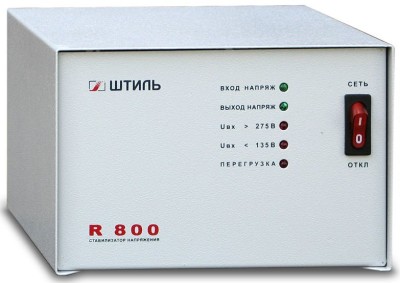 In order to support as many appliances that consume electricity as possible, a good one is needed. Moreover, it is still necessary to choose it correctly. The point is that this device can provide a different amount of equipment that "suffers" from a lack of voltage in the network, because the more subscribers are connected to the line, the more electricity they consume, the less it goes to those who live further in the neighborhood. It is especially bad for those who were last connected to the line - with the voltage that enters their network, only incandescent lamps work well.
In order to support as many appliances that consume electricity as possible, a good one is needed. Moreover, it is still necessary to choose it correctly. The point is that this device can provide a different amount of equipment that "suffers" from a lack of voltage in the network, because the more subscribers are connected to the line, the more electricity they consume, the less it goes to those who live further in the neighborhood. It is especially bad for those who were last connected to the line - with the voltage that enters their network, only incandescent lamps work well.
Therefore, the purchase of a voltage stabilizer is a top priority if there is not enough voltage in the house, or if there are constant surges in the network that can simply burn out all household appliances.
What are stabilizers, and which one to choose?
When you need to make voltages for giving, you will be faced with the fact that you will need a device for a network with a certain number of phases. This question needs to be dealt with before the store asks you the question, “what kind of device do you need?”, “how to choose the right one?” Determining this is easy enough. AT country house, in the country, you just need to see how many wires stretch to the meter. If there are only two of them, then this means that one phase for 220v is connected to the house. In this case, the choice is obvious.
But, in the event that you plan to install devices in the future that consume a large amount of energy, or operate from several phases, then it is better to immediately purchase the appropriate device. In the same case, if more than four wires stretch to the house, this means that three phases are connected - 380v. But for connection, you do not necessarily need to pick up a three-phase rectifier. If in everyday life you do not use any appliances that require high voltage, and do not plan to acquire them, then a single-phase stabilizer is perfect for you. Thus, faced with the problem of choice, you can always find the best solution. To do this, it is enough just to have more or less clear plans for the purchase of future appliances and the state of your power grid.
Useful video about voltage stabilizers for summer cottages
Choice of 1 phase
In the event that you still decide to choose a single-phase stabilizer, you will find a wide variety of this type of product and types of these devices.
Single-phase stabilizers are on the market in different design variations: relay, electromagnetic, thyristor, ferroresonant, electromechanical. The main differences between these devices are in the method of stabilizing the voltage in the network and their device.
All of them have different characteristics, depending on the device and different operational characteristics which make them more or less convenient to use. In everyday life, those types of rectifiers are usually used that do not have mechanical parts in their design - they work quietly, without making noise when switching, during switching they do not interfere with the network, so that the light does not blink or disappear. Also, depending on the cost of the device, single-phase stabilizers are equipped with additional features that make their work more productive. So, an increased number of steps allows them to work with the highest accuracy and speed, completely protecting equipment from voltage surges.
3 phase
With three-phase stabilizers, the situation is similar, but they are still, they differ significantly from single-phase devices.
In fact, a three-phase stabilizer is three single-phase sprockets connected together. The only major difference is that such a stabilizer provides a single protection system for all three phases. In the event of a malfunction, short circuit or overload, the device will turn off completely, regardless of which line has a breakdown.
But at the same time, voltage regulation, as well as the load on the phases, occurs independently, which allows the use of such devices for branching into three different single-phase lines, where each can carry a specific function. Among the three-phase stabilizer, there is not the variety that single-phase devices have due to technical reasons. Only electromechanical, electrodynamic and hybrid versions are suitable for operation in the connection. There is not much difference between them, but the electrodynamic voltage stabilizer is still more reliable and its cost is an order of magnitude higher than the price of stabilizers of the other two options.
Choice by power
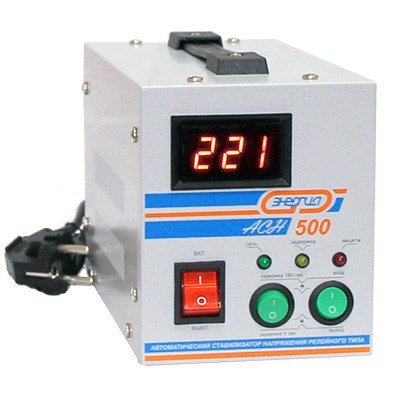 There are two ways to choose a stabilizer by power consumption. The first is to call a specialist. He will make all the necessary measurements, inspections and make his verdict on which of the stabilizers is suitable for your home network according to the nature of the load. The second way is to choose a stabilizer, focusing on the readings of the introductory machine. This is a device that is used to de-energize the entire line at the input. Usually it is located near the meter and has power limitations.
There are two ways to choose a stabilizer by power consumption. The first is to call a specialist. He will make all the necessary measurements, inspections and make his verdict on which of the stabilizers is suitable for your home network according to the nature of the load. The second way is to choose a stabilizer, focusing on the readings of the introductory machine. This is a device that is used to de-energize the entire line at the input. Usually it is located near the meter and has power limitations.
The machine is limited by the input current. It is measured in amperes, a value that is directly related to power and can be calculated using the appropriate tables. At 16 amperes, the maximum power consumption is 4 kilowatts, at 32 amperes - 8 kilowatts, at 63 amperes - 14 kilowatts for single-phase network. For a three-phase network with a current strength of 16 amperes maximum power will be equal to 12 kilowatts, for 32 amperes - 24 kilowatts, for 63 amperes - 42 kilowatts.
Also, for a three-phase network much larger loads are permissible, up to 500 amperes, while the maximum allowable power is 375 kilowatts. But such indicators are much higher than those used in the household and are more suitable for industrial enterprises and workshops.
For other features
Among other criteria that you need to navigate in order to choose the right stabilizer, you can note the ability to adjust the input voltage directly for specific devices. Among these, it is possible to single out household appliances manufactured abroad, where the standards of power networks differ from our domestic ones - their operation requires a voltage greater than 220V. Also, this applies to the voltage supplied to incandescent lamps, if it is less than 220V, then in this case they function much longer. Stabilization accuracy also significantly affects devices that are sensitive to voltage drops. The good functioning of the computer, the service life of its components, directly depends on the stability of the current. The level of stabilization also matters if the voltage surges in the network reach high levels, especially if they exceed the maximum allowable value.
The video tells about voltage stabilizers Energy for giving
Model overview
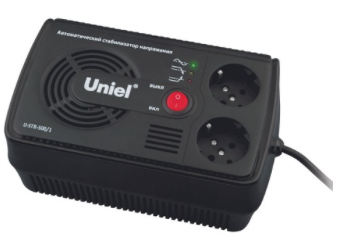
Installation, features of installation and connection
Installing a stabilizer is not difficult, but responsible.
The choice of the place where it will be located is the main key to its stable and long work years without breakage. Such a place, first of all, should be dry. Electronic devices do not like high humidity, and even more so condensate - it harms them, and they fail ahead of schedule. In such cases, it will not be easy, and you may even have to replace all the main parts that have failed. A voltage stabilizer is not a universal device designed for operation in different conditions- the temperature in the room where it will be placed must also meet certain requirements. For most devices, it ranges from +5 to +40 degrees Celsius.
These are the lowest and highest allowed values. In order to place the device in other conditions, it will need a protective cover - if it must work under low temperatures and the cooling system if it is to operate at temperatures above those specified. As for the position of the device, it can be placed both on the wall and on the floor, or on a stand. The most convenient option is to place it on the wall, in a vertical position, where it will not interfere at all. You can connect the stabilizer both directly to the network, and bypassing it, using a bypass. This connection method is better and more convenient - with its help it will be possible to physically turn off the device during work with a load on the network - welding, heating, or while the generator is running.
Another video about voltage stabilizers for home and garden
What do people say?
In any case, it is not worth abandoning the stabilizer, especially when it is needed and will bring unambiguous benefits.
In the country, we are often or not very much, depending on the season and time of year. In any case, in the country house there are some benefits of civilization, such as a TV, Electric kettle, maybe even, certainly there is a refrigerator. In order to ensure that during your absence as a result of power outages or emergency shutdown electricity did not happen troubles need to secure all devices that are connected to the mains. The stabilizer will help to cope with this task. Which voltage stabilizer 220v to choose for the country house, what its functions, the principle of operation and connection, we will describe in detail.
Voltage regulator
Voltage drops far from the standard 3-5% in one direction or another from 220 V are the norm today. This is due to the development of society, and, more correctly, due to an increase in the number of consumers, and hence the length of power lines. If your cottage is located near distribution substation, then the voltage will fit into the norm, and maybe even be higher than it, but if it is far away, then obviously it will not reach it.
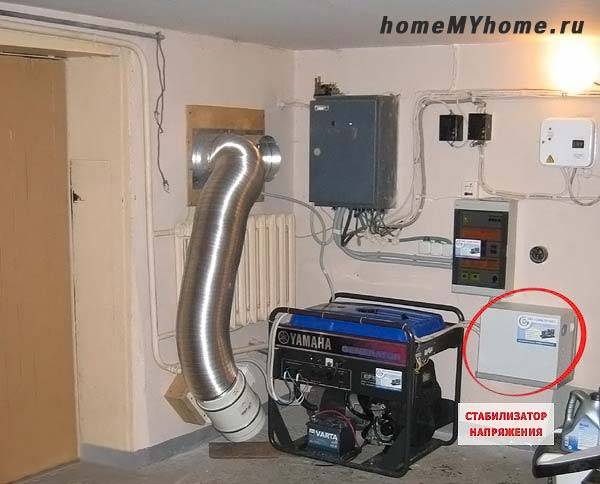
A voltage stabilizer is a device that is able to normalize the voltage supplied to electrical appliances. Over or under voltage will not benefit the technique, and that is why it is important to know which 220v voltage regulator to choose for a summer residence. Its main purpose is to normalize the voltage so that the devices receive standard 220V.
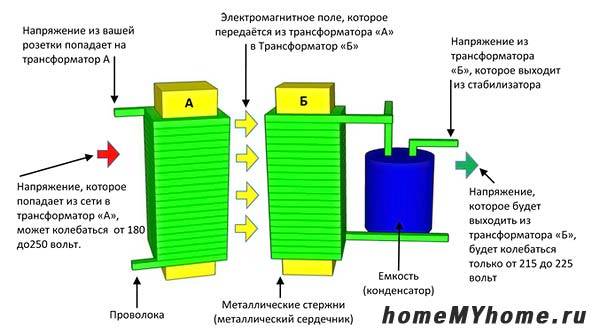
Video: how to choose a voltage stabilizer
Kinds
There are 3 types of 220V stabilizers in total, which can be installed not only in the country, but also in the house or apartment. Namely:
- Servo-driven - these devices work on the principle of changing the number of turns on the transformer. The mechanism that is responsible for stabilization is a servo drive, it starts the runners along the transformer turns. Such a stabilizer has a low price, but since it contains many mechanical components, its reliability is far from ideal.
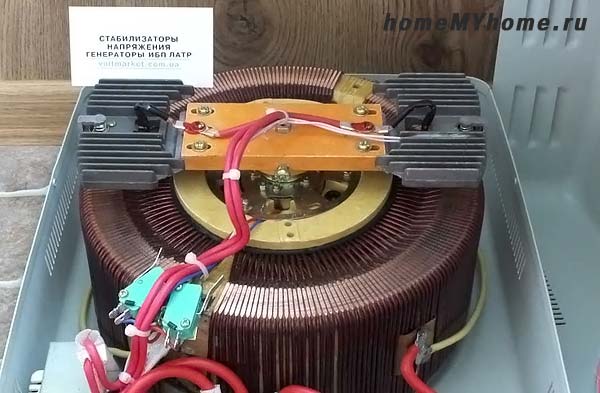
- Relay - here the main task of stabilizing lies with power relays. They then work to switch the winding of the transformer. Such devices are also not very expensive, but also not very durable due to the presence of mechanical parts in the relay. Frequent problem is the sticking of contacts, which does not accompany a long life.
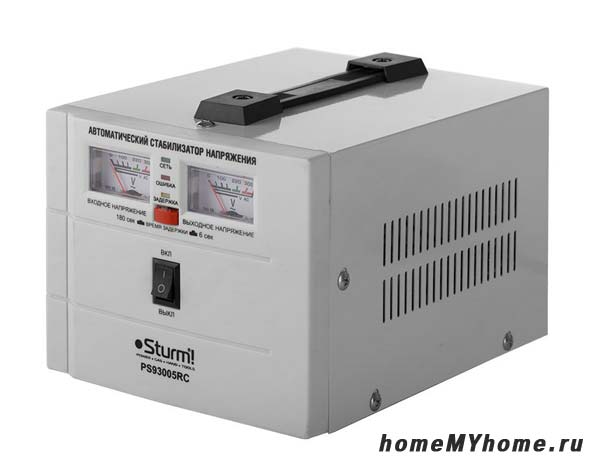
- Electronic - the most expensive, but also the most reliable. They have what a good device needs in order to produce the correct voltage - this is speed, noiselessness.
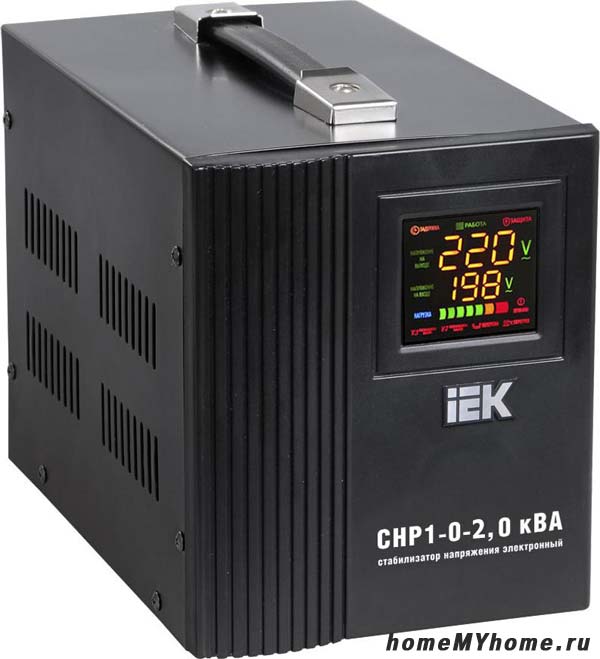
Calculation of the stabilizer
In order to calculate the power of a voltage stabilizer, you need to know its characteristics, namely the total or rated power. This concept includes active and reactive load, and the starting current should also be taken into account.

Active power
It is measured in watts. This is such a load for which it is used, which is converted into other types of energy, for example, into light and heat. Examples of such devices are irons, televisions.
Other loads belong to this type. It includes capacitive and inductive power, here it is important to take into account the full and active loads, the cos coefficient is always “connected” with them. To make it clearer, let's take an example:
We have an angle grinder, its power is 2000 W, its cos is 0.6. To calculate the total power, the first indicator must be divided by the second:
2000/0.6=3333 W
This coefficient is not always indicated on the instruments. Its average is 0.7 and you can rely on it in calculations.
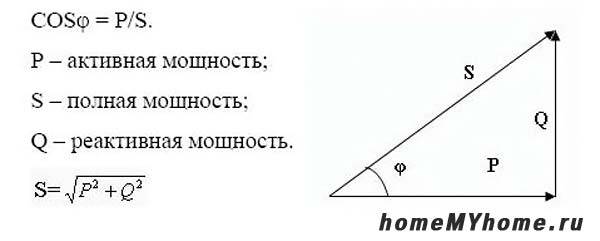
Currents
Take into account starting currents. All devices that have an electric motor at the time of launch give out a lot of power. To calculate it, you need to multiply the indicator indicated in the characteristics by 3. So if you have a refrigerator with a power of 250 W in your country house, then at the moment you plug it into the outlet, the total power is approximately 750 W. And this must be taken into account when choosing a device.
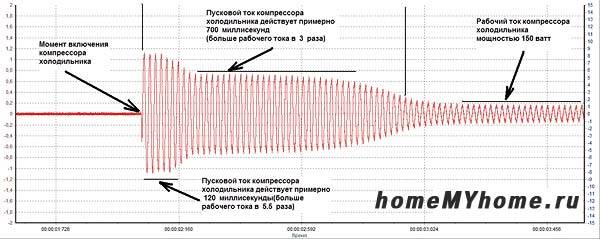
What should be the power of the stabilizer?
The required power of the stabilizer is the sum of the powers of the devices that are planned to be connected to it. Given that there are not very many of them in the country, it is better to connect everything, so it will be safer. Again an example:
If you have a TV in your country house (on average it is 100 W), a refrigerator (200 W), lighting (about 250 W in total), a heater (2,000 W). Then the calculation of the power of the stabilizer occurs as follows.
100*3+200*3+250*3+2000*3=7650W, this is taking into account the starting currents.
You will need to look for a stabilizer with at least 8 kW. The more powerful your devices, the more they need a stabilizer.
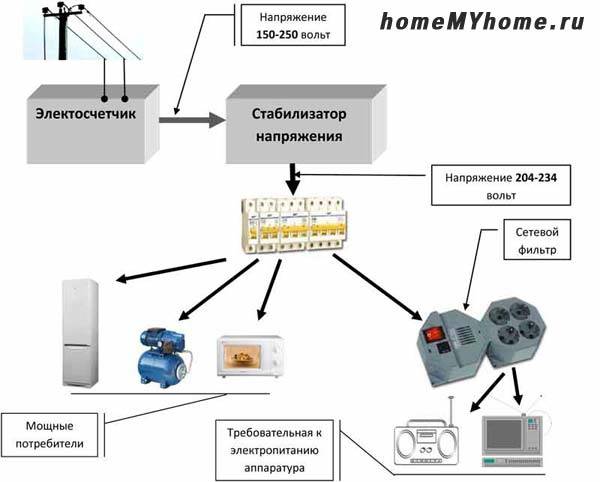
Calculator for calculating the current-voltage characteristics of a voltage stabilizer
Wiring diagrams
When connecting the stabilizer, there should be no current in the network. It is most rational to connect immediately after the meter, before the load. The connection is made in series, in the break of the phase wire. Often, manufacturers put a connection diagram on the body of the device.
The stabilizer most often has 3 contacts for connection: these are input, output and zero.
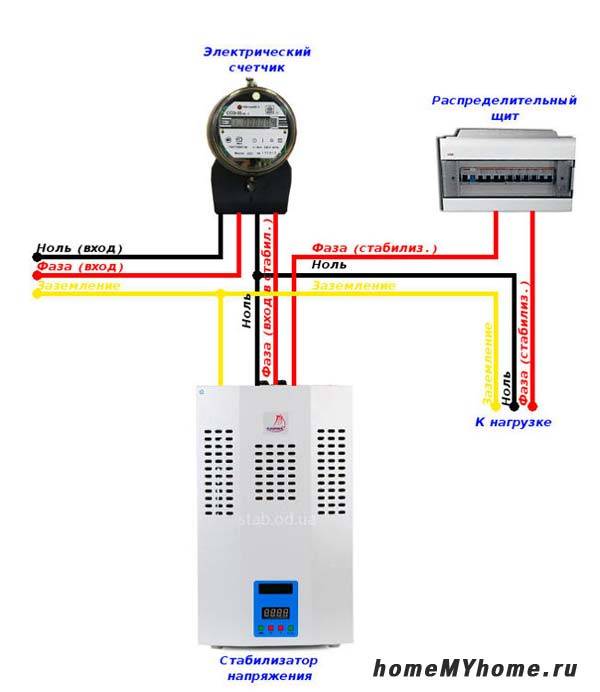
Sometimes the stabilizer circuit has 4 contacts: 2 inputs and 2 outputs. In this case, the connection is made as follows: the phase and zero are connected to the input machine and to the corresponding “input” contact. The load wires (phase and zero) are connected to the "output".
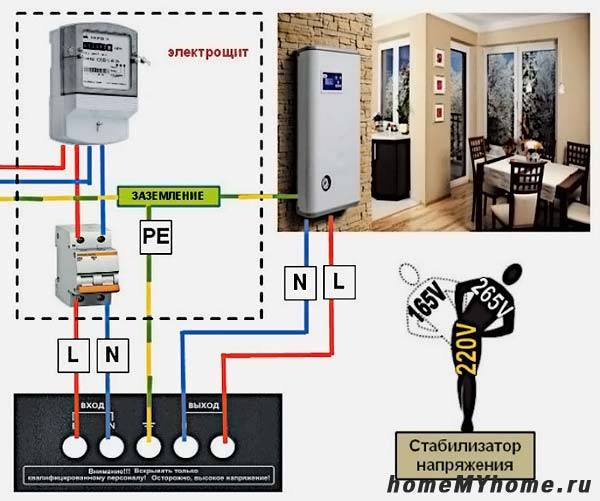
After connecting, it is important to check the correct connection. Before switching on for the first time, you must disconnect all appliances from the mains, turn off the lamps. After turning on the device, check the absence of extraneous noise, crackling.

Voltage stabilizer at work
Service
Whatever stabilizer you choose, you need to carry out its regular maintenance. It includes tightening connections, screw and bolt. This will help to avoid fire hazards and insulation damage, this is always important, and especially in a country house, since you do not live in it permanently. Weak contact or a loose bolt can cause a fire, it is better to prevent such situations than to pay or be punished later.
Almost every owner of a country house is struggling with power supply, these are surges, voltage drops, various kinds of interference in the network. And when a decision has already been made to acquire a high-quality network regulator, many immediately have a question: But, it is a properly selected electrical appliance that will become a reliable assistant, be able to ensure stable operation of household devices, and increase their performance for many years.
We all know that Appliances, which is used in our homes, unlike the current one, has higher parameters. And accordingly, it already imposes other requirements on the quality of the power supply. As a result, with a slight change in the voltage in the network, the connected household appliances work in the wrong mode, their state of operation is disturbed. And at the moment, strong jumps, they generally fail. Therefore, the installation of a reliable network stabilizer in the country is extremely important and even necessary.
The first step in choosing a stabilizer is to determine the phases
If there is a single-phase electrical network in the summer cottage, then without a doubt we choose. When the number of phases is three, there are two choices. The first is the purchase of one, the second is to deliver immediately three single-phase stabilizers (220 V). Moreover, it is much better to use the last case, since in the absence of two phases out of 3, work will continue on one. What will not happen in the initial version.
But it's worth considering , if present in electrical equipment three-phase motor, it would be wiser to connect one .
Find out what power you need to choose a voltage stabilizer 220V for a summer residence?
First, pay attention to the power of the device, it is shown in watts or Kilowatts. And in principle, in order not to engage in tricky calculations, you can take into account the entire reactive load. A small margin of power may come in handy in the future. Than a disadvantage that can have a detrimental effect on work.
Next, let's say you use in your country house appliances such as refrigerators, televisions, electric heaters, submersible pump for a well, and together with this lighting (five incandescent lamps, each 100W).
If installation is required stabilizer for electrical equipment with el. engine, then when calculating the power of the normalizer, it is recommended to take the starting power. It could be an order of magnitude higher nominal value (2-7).
Since the simultaneous start-up of the refrigerator and the pump is practically impossible, the starting indicator does not need to be summed up, and the total load of the plot in the country house will be connected to one network stabilizer. And if this happens unexpectedly, only comfort will be a loss. Thus, it is best to get a stabilizer of sufficient power or with a margin.
We choose a 220V stabilizer for giving with optimal technical parameters
Having decided on the rated power, you can begin the selection of the regulator that is most suitable for operation in the country.
According to the method of fastening.
As a rule, houses in suburban areas are not built large, and finding a place to install is sometimes not so easy. That's why, the best option is , whose body is universal. Rear end construction has special fasteners, and with the help of them it is easy hangs on the walls . These devices, unlike floor-standing ones, weigh no more than 50 kg and have convenient compact dimensions.
Ambient temperature.
For operation in a summer cottage, they are most often installed, given the fact that many summer residents do not always live in their home, and the premises do not have constant heating. Stabilizers with a wide temperature range able to perform their tasks, even with small frosts, up to -30°C. And this opportunity allows them to be used all year round.
Operating principle.
Knowing the power consumption and the recommended technical capabilities, best voltage stabilizer on the 8 , 10 , 15 kVA, relay and thyristor type .
Relay single-phase stabilizer(regulates AC voltage 220V with a deviation of 10%, operates in the operating range 105-270V. It also has a stepped type of stabilization, withstands short-term overloads up to 110%. Refers to relatively inexpensive stabilizers.
Thyristor (triac) stabilizer() at a price much more expensive, but at the same time it mainly has speed, overload capacity (180%). It features absolutely silent operation and high stabilization accuracy (3%). household stabilizer Equipped with high quality parts, unpretentious in operation, durable.
Modern summer cottages today they represent full-fledged residential facilities, which often use a large number of different equipment, and as practice shows, it is outside the city that there are the most serious emergencies with the supply of electricity in a single-phase and three-phase network. In connection with this problem, we are often approached with the question of which stabilizer is better for a country house. But looking ahead, in order to choose a truly optimal model, you need to fully understand the problems in power supply, determine the type of power supply (1-phase or 3-phase) and know in what conditions such network equipment will be used.
Single-phase or three-phase - how to choose a voltage regulator for a summer residence.
First of all, you need to accurately determine the number of phases connected to your country cottage. This is one of the most important points, since any electrical appliance is fundamentally different from each other. You can find out in the following simple ways:
- look at the phases in the relevant documents on power supply, which should be for each country house;
- look at the main switchboard for the number of incoming wires. If there are more than 4, then you have three-phase network, if less, then this is a 1-phase connection;
- Also, the type of network can be recognized by the LED indicators located on the meter itself. On a 3-phase there will be 3 such indicators, on a single-phase - only 1.
Voltage stabilizer for giving 220V, which one is better for 10 kW?
 The most common for a modern country house is a power of 10 kW, since recently household consumers such as electric stoves, refrigerators, pumps, heaters, TVs, air conditioners and other equipment that make our life more comfortable and convenient are being used more and more in the suburban sector. . Our branded online store offers to buy Russian certified devices and premium and middle class devices that are most adapted to simple and complex domestic conditions around the clock operation. To choose the right automatic voltage stabilizer for yourself, you must answer yourself the following 3, and perhaps the most important questions:
The most common for a modern country house is a power of 10 kW, since recently household consumers such as electric stoves, refrigerators, pumps, heaters, TVs, air conditioners and other equipment that make our life more comfortable and convenient are being used more and more in the suburban sector. . Our branded online store offers to buy Russian certified devices and premium and middle class devices that are most adapted to simple and complex domestic conditions around the clock operation. To choose the right automatic voltage stabilizer for yourself, you must answer yourself the following 3, and perhaps the most important questions:
- What type are you electrical network(for 220V or 380V)?
- In what voltage range do surges and drawdowns occur in the power grid?
- Will this mains electrical equipment be installed in a heated or unheated room?
If you know the answers, then the problem with choosing a voltage stabilizer is simplified by 90%, since the rest of the indicators are mostly additional and, as a rule, are aimed at providing maximum convenience, reliability and comfort in the future. Today we are ready to offer for order the following domestically produced 220V stabilizers for a single-phase electrical network: Energy ASN 10000, Energy Voltron 10000 and Energy Hybrid 10000. Consider their main specifications and opportunities, relying on which, you can easily choose for yourself the most suitable option for your home network alternating current and tension.
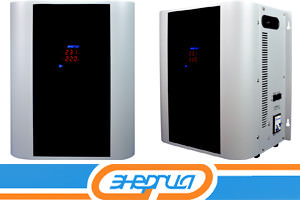 It is the best low-noise model of the presented network devices for a single-phase 220V network. Voltage equalization range from 105 to 280 volts. Functions automatically in two modes (electromechanical + relay). Capable of maintaining a pure sine waveform. Type of installation - wall / floor. Works well with conventional and highly sensitive equipment, as it has a high accuracy (± 3%) of adjustment. In the process of smoothing out the differences, the bulbs do not flicker, thanks to smooth, non-breaking stabilization. It is in great demand for giving with permanent residence. The winding of the transformer is made of copper. Manufacturer - Russia. There is a multi-level protection. There is one drawback - it is not adapted for operation at low negative temperatures. Permissible climatic conditions of use from -5 to +40 degrees Celsius. .
It is the best low-noise model of the presented network devices for a single-phase 220V network. Voltage equalization range from 105 to 280 volts. Functions automatically in two modes (electromechanical + relay). Capable of maintaining a pure sine waveform. Type of installation - wall / floor. Works well with conventional and highly sensitive equipment, as it has a high accuracy (± 3%) of adjustment. In the process of smoothing out the differences, the bulbs do not flicker, thanks to smooth, non-breaking stabilization. It is in great demand for giving with permanent residence. The winding of the transformer is made of copper. Manufacturer - Russia. There is a multi-level protection. There is one drawback - it is not adapted for operation at low negative temperatures. Permissible climatic conditions of use from -5 to +40 degrees Celsius. .
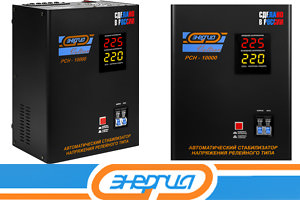 Production - Russia. Works flawlessly at reduced (from 100V) and at increased (up to 280V) voltage. Easily withstands sub-zero temperatures from -30 to +45 °C (frost-resistant, moisture-resistant). Virtually inaudible - low noise. Has wall and floor installation method. Equipped with 5-step protection. Fully automatic. Copper winding. Ideal for a country cottage, but there is one small drawback - during operation (especially with a very low power supply), lighting flickering is possible. Not recommended for highly sensitive electrical applications as the smoothing accuracy is only ±10%. .
Production - Russia. Works flawlessly at reduced (from 100V) and at increased (up to 280V) voltage. Easily withstands sub-zero temperatures from -30 to +45 °C (frost-resistant, moisture-resistant). Virtually inaudible - low noise. Has wall and floor installation method. Equipped with 5-step protection. Fully automatic. Copper winding. Ideal for a country cottage, but there is one small drawback - during operation (especially with a very low power supply), lighting flickering is possible. Not recommended for highly sensitive electrical applications as the smoothing accuracy is only ±10%. .
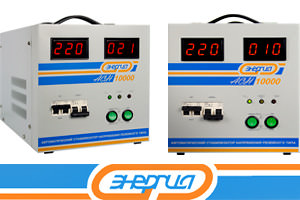 The most budget brand of all Russian devices in our online store, which is mainly in demand for the dacha sector with a non-permanent place of residence. Range from 120 to 280 Volts. Output Accuracy after Mains Drop Leveling ±8%. Low noise level. Frost-resistant - suitable for use in rooms with negative temperature-20 to + 40°C. Installation, floor only. The winding is aluminum. There are several levels automatic protection. The disadvantage is the flickering of the bulbs during severe failures. Made in Russia. .
The most budget brand of all Russian devices in our online store, which is mainly in demand for the dacha sector with a non-permanent place of residence. Range from 120 to 280 Volts. Output Accuracy after Mains Drop Leveling ±8%. Low noise level. Frost-resistant - suitable for use in rooms with negative temperature-20 to + 40°C. Installation, floor only. The winding is aluminum. There are several levels automatic protection. The disadvantage is the flickering of the bulbs during severe failures. Made in Russia. .





